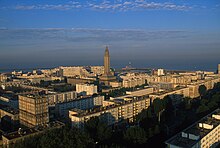History of Le Havre
Le Havre was founded on 8 October 1517 as a new port by royal command of François I partly to replace the historic harbours of Harfleur and Honfleur which had become increasingly impractical due to silting-up.
[1] Many remains from the Neolithic period have been excavated in the lower city and the Montgeon Forest [fr]:[2] it is at this time that the population increased and settled down in the first hamlets.
A Roman road linked Lillebonne (Juliobona) at the mouth of the Seine through the current territory of the commune of Le Havre.
[citation needed] On 8 October 1517, François I signed the founding charter of the port the plans of which are first assigned to Vice Admiral Guyon le Roy.
[5] The New World attracted adventurers and some left from Le Havre such as Villegagnon who founded a colony in Brazil (Fort Coligny) in 1555.
At the end of the 16th century trade expanded quickly and Le Havre saw the arrival of American products like leather, sugar, and tobacco.
It was not until 1787 and the Edict of Versailles of King Louis XVI that Le Havre reopened a Protestant place of worship in the district of Saint-François.
The troops of Charles IX, commanded by Anne de Montmorency, attacked Le Havre and the English were finally expelled on 29 July 1563.
The defense function of Le Havre was reaffirmed and modernization of the port began in the 16th century on the orders of Cardinal Richelieu, governor of the city: the arsenal and the Roy Basin were developed, the walls were reinforced and a fortress built.
At the beginning of the reign of Louis XIV, Colbert decided to renovate the port infrastructure and military: the work lasted 14 years.
[8][10] In 1707 Michel Dubocage, a Captain from Le Havre, explored the Pacific Ocean aboard the Discovery and reached the Clipperton Island.
Upon his return to Le Havre, he made his fortune by setting up a trading house and bought a mansion (now a Museum) in the heart of the Saint-François district and the lordship of Bléville.
The national events of the French Revolution were echoed in Le Havre: delegates for the List of Grievances were elected in March 1789.
Throughout the 19th century, the cosmopolitan aspect of the city only strengthened: in times of maritime prosperity, the workers of the Pays de Caux were driven to Le Havre because of the crisis in the weaving industry.
The industrial sector, however, remained in a minority in the 19th century: the plants were related to port traffic (shipyards, sugar refineries, rope factories, etc.).
On the eve of the First World War Le Havre was the primary European port for coffee,[19] it imported some 250,000 tonnes of cotton and 100,000 tons of oil.
[20] The human toll from the First World War was heavy for the city: Le Havre suffered about 6,000 dead, mostly soldiers who left to fight.
One of the notable facts of the war was the installation of the Belgian government at Sainte-Adresse on the outskirts of Le Havre as they had been forced to flee the German occupation.
[23] They made a naval base in preparation for the invasion of the United Kingdom (Operation Sealion) and set up the Festung Le Havre,[24] lined with bunkers, pillboxes and artillery batteries integrated into the Atlantic Wall.
For the people of Le Havre, daily life was difficult because of shortages, censorship, bombings and political anti-Semitism: Mayor Léon Meyer was forced to leave his post because of his Jewish origins.
Much of the population opted to evacuate at dusk by foot, bicycle or wagon, only to return during daylight hours after the Allied Forces air bombardments were over.
The greatest destruction, however, occurred on 5 and 6 September 1944 when the British Royal Air Force[26] bombed the city centre and the port to weaken the occupier under Operation Astonia – often described as the storm of iron and fire.
Despite the extensive damage, Le Havre became the location of some of the biggest Replacement Depots, or "Repple Depples" in the European Theatre of Operations in World War II.
[30] In spring 1945, Raoul Dautry of the Ministry of Reconstruction and Urban Development[31] entrusted the project to rebuild the city of Le Havre to Auguste Perret.
The city council requested Brunau form part of the planning team, but subsequently he left a short time later due to creative conflicts with Perret.
[22][33] The triangular axis of the Boulevard François I, the Avenue Foch and Rue de Paris led the traveller north, south, east and west of the town centre.
The inclusion of 7.7 square kilometres (3.0 sq mi) of green spaces with parks, gardens and woodlands added to the port’s urban renewal.
In the 1970s economic difficulties due to de-industrialization saw, for example, the closure of Ateliers et chantiers du Havre (ACH) in 1999 and transformed the trade of the port.
UNESCO declared the city centre of Le Havre a World Heritage Site on 15 July 2005 honouring the "innovative utilisation of concrete's potential".
The 133-hectare space that represented, according to UNESCO, "an exceptional example of architecture and town planning of the post-war era," is one of the rare contemporary World Heritage Sites in Europe.












